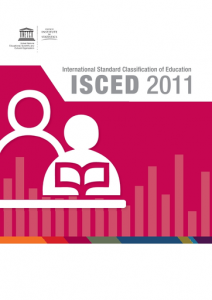The levels of education system invariably come in different grades and stages all across the world. Although different countries run educational systems differently, the differences honorably fit within the framework of the International Standard Classification of Education which is known as ISCED.

The International Standard Classification of Education provides a comprehensive framework for organising education programmes and qualification by applying uniform and internationally agreed definitions to facilitate comparisons of education systems across countries.
The world’s education systems vary widely in terms of structure and curricular content. Consequently, it can be difficult to compare national education systems with those of other countries or to benchmark progress towards national and international goals.
Levels of education are an ordered set of categories, intended to group educational programmes in relation to gradations of learning experiences and the knowledge, skills and competencies which each programme is designed to impart in the individual. Levels of education are therefore a construct based on the assumption that education programmes can be grouped into an ordered series of categories which represent broad steps of educational progression in terms of the complexity of educational content. The more advanced the programme, the higher the level of education.
The Different Levels of Education System
The International Standard Classification of Education 2011 classification consists of nine different levels of education system, these are:
1. Early childhood education (level 0)
Early childhood education, also called nursery education, is a branch of education theory that relates to the teaching of children (formally and informally) from birth up to the age of eight. Traditionally, this is up to the equivalent of third grade. The early childhood education is concentrated on and made to unify the important period in child development as one of the different levels of education.
2. Primary education (level 1)
This is another one of the different levels of education. Primary education provides learning and educational activities typically designed to provide students with fundamental skills in reading, writing and mathematics (i.e. literacy and numeracy) and establish a solid foundation for learning and understanding core areas of knowledge and personal development, preparing for lower secondary education.
It is typically the first stage of formal education, coming after preschool/kindergarten and before secondary school.
3. Lower secondary education (level 2)
Lower secondary education follows on from the fifth and last grade of primary school and lasts four years (grades 6 – 9). It forms the second part of compulsory schooling. It is one of the different levels of education system.
4. Upper secondary education (level 3)
Upper secondary education, as one of the different levels of education system, allows for every student who successfully completes basic education to have access to upper secondary education. Upper secondary education comprises three years of schooling (grades 10, 11 and 12) and is currently compulsory for all students aged up to 18.
5. Postsecondary non-tertiary education (level 4)
Post-secondary non-tertiary education is provided at upper secondary schools as vocational training centers, technological schools, and other training institutions accredited by the Ministry of Education. It prepares the children for labor market entry as well as for tertiary education. As one of the different levels of education system, post-secondary non-tertiary education aims at the individual acquisition of knowledge, skills and competencies lower than the level of complexity characteristic of tertiary education.
6. Short-cycle tertiary education (level 5)
Short-cycle tertiary education (SCTE) refers to the types of programmes typically offered by community colleges and similar educational institutions, of at least two years duration, and predominantly vocationally oriented.
7. Bachelor’s or equivalent level (level 6)
The bachelor’s or equivalent level is designed to provide participants with intermediate academic and/or professional knowledge, skills and competencies, leading to a first degree or equivalent qualification. They typically have a duration of three to four years of full-time study at the tertiary level. This level is more for the individual that is a bit mature and capable of analytical thinking and it is one of the different levels of education system. In addition, participants at the bachelor’s or equivalent level are expected to actively engage in preparing comprehensive course notes and completing various assignments to reinforce their understanding and application of the learned material.
8. Master’s or equivalent level (level 7)
At this level, students are already mature and are expected to possess advanced knowledge of a specialized body of theoretical and applied topics; high order skills in analysis, critical evaluation, or professional application; and the ability to solve complex problems and think rigorously and independently. Admission to a master’s degree normally requires successful completion of study at bachelor’s degree level either (for postgraduate degrees) as a stand-alone degree or (for integrated degrees) as part of an integrated scheme of study.
9. Doctor or equivalent level (level 8)
This is the last of the different levels of education system, and it is the highest any individual could get to in universal education. Programmes at this ISCED level are devoted to advanced study and original research and are typically offered only by research-oriented tertiary educational institutions such as universities. Doctoral programmes exist in both academic and professional fields. In most universities, the career lasts for 6 years.

Visit this cool virus site!